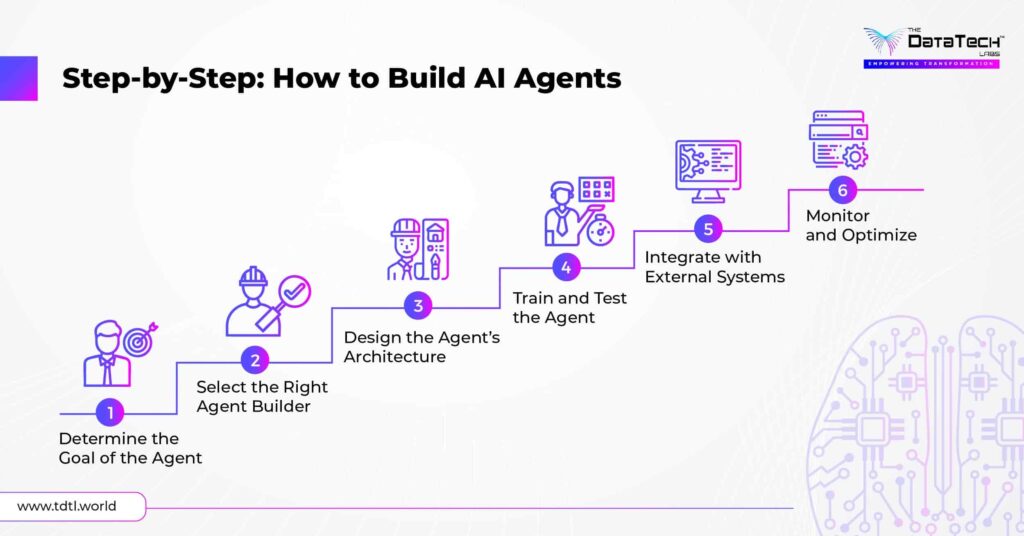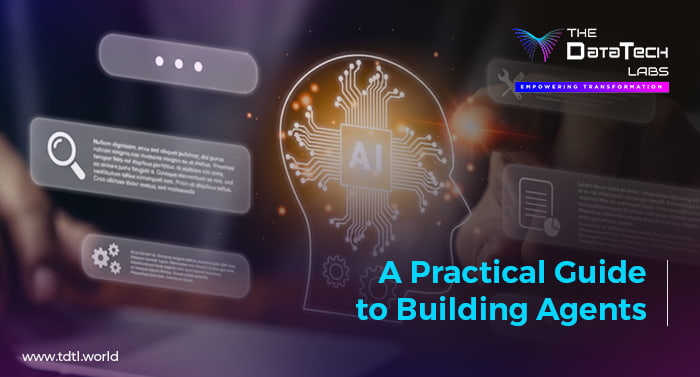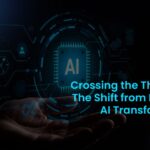AI extends beyond chatbots and predictive models. We are approaching a new phase of AI agents, smart systems that perceive their environment, make decisions, and act autonomously. In organizations, AI agents will automate workflows, provide real-time insights, and augment human teams in ways we can’t yet imagine.
Many organizations are trying to understand how they will develop AI agents that will create real business value. This guide should provide a pragmatic roadmap that includes important concepts, tools, and steps from curiosity to deployment.
What Are AI Agents?
An AI agent is a system developed for the purpose of interacting with its surroundings, reasoning through its tasks and actions, with little to no human assistance. Whereas static AI models receive input and respond, agents are different because they can plan, adapt and learn over time.
Here are some examples of AI agents in practice:
- Customer support bots: These bots respond automatically to the majority of common inquiries but seamlessly escalate more complex inquiries to humans.
- Research assistants: These agents can analyze and summarize vast datasets or large volumes of technical literature to inform decisions.
- Workflow automation bots: These agents effectuate approvals, update records or orchestrate interactions between systems without manual input.
By building AI agents, organizations can reduce repetitive work, increase productivity and provide new and innovative opportunities for operational, service delivery or customer conversations that establish new competitive advantages.
Core Concepts of Building AI Agents
Before selecting tools, frameworks or products to use in your agents, it will be useful to know some of the basic elements of an agent:
- Perception: The understanding of the environment through the interpretation of a variety of inputs such as text, voice, images or hierarchical data.
- Reasoning & Planning: Taking in information for analysis and contemplation to determine the best actions to take using logical rules, machine learning models or predictive algorithms.
- Action & Execution: Executing a task via APIs, automation scripts or system commands.
- Memory: Using context from previous interactions to make better choices and responses in the future.
When exploring how to build an AI, think of it as designing a system that integrates these components into a workflow that aligns with business goals.
Essential Agent Tools and Frameworks
There’s a growing ecosystem of agent tools that make it easier to create, test, and deploy agents. Some of the most widely used include:
- LangChain: Enables context-aware AI applications, particularly with LLMs.
- AutoGen: Supports collaboration between multiple AI agents to handle complex tasks.
- CrewAI: Specializes in orchestrating agents for enterprise workflows.
- Low-code or zero-code AI platforms: Allow non-technical teams to build and deploy agents quickly.
When selecting an agent builder, consider factors such as scalability, integration capabilities, learning curve, and compliance requirements. Open-source frameworks are flexible, while enterprise-grade platforms provide robust support and security.
Step-by-Step: How to Build AI Agents
Step 1: Determine the Goal of the Agent
The first step is to focus on a specific use case: are we building this agent to automate customer support, to internally manage workflows, or to assist with research or writing? The clearer the purpose of your agent, the easier it is to define realistic outcomes to measure success and avoid building complicated solutions.
Step 2: Select the Right Agent Builder
Select an agent builder that meets your needs numerically and fits into your organization technically and operationally. If you want to experiment with building an agent, then open-source libraries such as LangChain provide the best platform. If you are in a highly regulated environment and know compliance will be an issue, then enterprise platforms are the better choice.
Step 3: Design the Agent’s Architecture
Outline how your agent will handle inputs, reason through decisions, and perform actions. If your agent needs to retain context across multiple interactions, include memory features. Using a modular design allows you to upgrade, update or replace existing components without affecting the other components.
Step 4: Train and Test the Agent
Prepare your datasets and any models needed for fine-tuning, and test interactions before deploying. When testing, be sure to simulate both normal scenarios and edge cases.
Step 5: Integrate with External Systems
The value of an agent is from it being able to interact with real-world systems. Integrate with external systems such as CRMs, knowledge bases, or other APIs to let the agent execute tasks seamlessly.
Step 6: Monitor and Optimize
After deployment, understand how the agent is performing related to desired key performance indicators such as task completion, accuracy, and response time. Use analytical tools to identify bottlenecks or misbehaviors in the agent’s performance, and refine the agent continuously.

Common Challenges in Building AI Agents
There are challenges in building AI agents especially in an enterprise setting:
- Data quality: Without quality data, outputs will be unacceptably weak. You must be diligent and think deeply in curating the data you use.
- Bias/fairness: You should think deeply about the representation of each dataset, as well as the limits of the outputs so they can meet ethical parameters.
- Security/compliance: You’ll want to vet any agent against data privacy laws, as well as your own policies.
- Scalability: Avoid planning to fail; if you expect growth you’ll want a modular architecture to absorb any growth in workload with no degradation.
Tactful decisions upfront can save money and ensure your agents function appropriately and effectively.
Best Practices for Robust AI Agents
- Begin small: Utilize your agent in a pilot capacity, focusing on a single domain before making the decision to expand.
- Human-in-the-loop: Include human involvement for making high-stakes decisions.
- Explainability: Provide stakeholders with an explanation for the agent’s outputs.
- Modular: Select frameworks and agent tools that support swapping in new models (without having to recreate the transfer/act process).
- Continuous learning: Retrain agents on a regular basis to account for new data or business processes.
The Future of AI Agents
Companies are moving toward multi-agent ecosystems, which are collections of specific agents that collaborate against more complex issues. The arrival of low-code and zero-code platforms has removed technical barriers to entry, allowing more teams to rapidly establish experiments and deploy AI agents in their products.
In figuring out how to create an AI agent today, companies will gain the advantage of knowing how to best use the offering before it becomes a commodity. Thus, doing AI agents ahead of and while the multi-agent trend expands indeed offers more competitive and operational advantage.
Conclusion
Building AI Agents does not require a large development team but should start with objectives, the appropriate tools for the college objectives, and a framework to break it down to simplify the approach to agent development. With thought and planning, the judicious use of agent development tools, and ongoing testing, businesses will develop agents that also will save time, reduce expense, and generate efficiencies in other opportunities.
The future of work is becoming more autonomous, and businesses that start to experiment now will make themselves contenders for the future.
FAQ's
AI agents are adaptive and capable of learning from interactions, whereas traditional automation tools follow predefined rules without evolving or reasoning.
Yes. With proper integration, AI agents can collaborate across teams—handling tasks in HR, finance, customer service, and operations simultaneously.
Natural language understanding allows agents to interpret text or speech inputs accurately, enabling more human-like interactions and smarter decision-making.
Success can also be measured by improved decision quality, user satisfaction, error reduction, and the agent’s ability to handle increasingly complex tasks autonomously.
Yes. Regulatory requirements, domain-specific data availability, and operational constraints vary by industry, affecting agent design, deployment, and monitoring strategies.





Knowledge Based Agents in AI: Unlocking Intelligent Decision-Making - Blogs
[…] Customer Interaction: AI agents facilitate multi-step customer workflows by logically accessing a knowledge base containing concise […]
seo for shopify store
I’m impressed, I have to say. Really rarely do I encounter a weblog that’s both educative and entertaining, and let me let you know, you’ve hit the nail on the head. Your thought is outstanding; the difficulty is one thing that not enough persons are talking intelligently about. I’m very completely satisfied that I stumbled throughout this in my search for something relating to this.